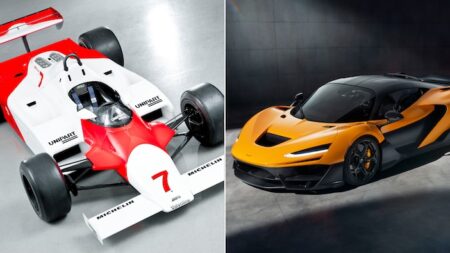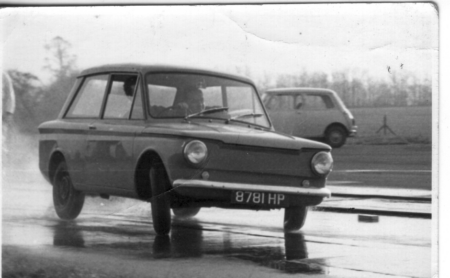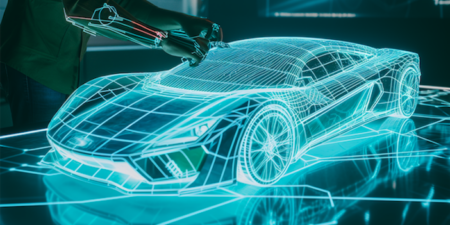In the last issue of Vehicle Dynamics International, I chose the DC2 Honda Integra Type-R as another entry in to the regular Dynamic Legends feature. It was chosen largely because of the car’s prowess but also partly because we featured the all-new NSX in the front end of the magazine. Another reason was in anticipation of this, the all-new FB generation Civic Type-R. It’s quite the departure from its predecessors. Much like the regular Civic, the Type-R retains the five-door bodyshell option only; the proceeding EK9, EP3, and FN2 models have all been three-door only. The FB also steps away from the Type-R’s signature naturally aspirated, high-revving power train too, adopting a turbocharged engine with the red line set at a relatively modest 7,500rpm.
But what links this latest car to its family tree is in its singular focus on driver involvement – the car is only available with a manual transmission for example – and all of the car’s aerodynamically appendages are functional additions that generate ‘genuine’ negative lift on both axles.
Development of the car has been split largely between the Nurburgring Nordschlife, Germany, and several domestic race circuits in Japan such as Honda’s own Takasu circuit, Tskuba, and Suzuka. As the Type-R’s Large Project Leader, Hisayuki Yagi explains, the project was clearly defined right from the outset. “For the Type-R this time, the focus was to not only have the most high-performing Type-R in Honda’s history, but also the most high-performing product in the segment.”
Despite achieving this, the new Type-R delivers 310Ps and 400Nm, Honda has chosen to stick with its tried and tested front-wheel drive orientation, meaning that the front wheels are effectively dealing with 50% more power and torque than any other variant in the Civic range. To help traction, and reduce torque steer, Honda has developed what it refers to an Advanced Dual Axis Strut Front Suspension system. Similar in concept to Ford’s RevoKnuckle, the compact unit separates the upright’s functions to two separate entities.
“We reduced the center offset difference by separating the functionality of the strut,” explains Yagi-san. “As the knuckle is now separate, it also acts as a turning device as the kingpin angle can be inclined much more as a result of bringing the turning axis of the knuckle much closer to the center offset. In comparison to the standard Civic, we have reduced the center offset by around 50%.”
Honda claims that this has helped reduce torque steer by 50%, when used in combination with its revised drive shafts. “The drive shafts that have been balanced and weighted,” explains Yagi. “They are unequal in length, which is where the problem of torque steer originates from, but the rigidity for the two is equal so the deformation is the same for both.”
With several key rivals, such as the Mercedes A45 AMG, Volkswagen Golf R, and the forthcoming Ford Focus RS, adopting all-wheel drive systems to handle the increased power outputs, was AWD ever an option for the Type-R?
“The fact that Honda has stuck to the FWD system, is more to do with Honda’s MM principle of development,” explains Yagi-san. “MM stands for ‘man maximum, machine minimum’ – in which we try to minimise the space for the mechanics, to increase the space for occupants.
“We also seek the best balance between layout, package, performance and efficiency,” he continues. “Technically, it would be easy; you put in the four wheel drive system, you increase the power, you make a bigger engine, you make a bigger car. Therefore you put bigger wheels and tires on it, and ultimately you end up with a much more exotic specification – but whether it would be quicker around the Nurburgring, or anywhere for that matter, is a big question mark. The NSX, the S2000, and the Civic Type-R are all good examples of following that MM principle of not adding anything to the car that won’t improve it dynamically. That’s the reason why we’ve stuck to the 2WD system.”
One thing that has been added to the Type-R to improve the dynamics is a new, unique, adaptive damper system, which operates continuously. Using a valved damper body, the units also feature an internal electromagnetic coil that is connected to ‘multiple’ sensors that update the dampers ECU every 1/500th of a second. The valves control oil flow through the damper increasing or decreasing the dampening accordingly.
Honda states that a unique algorithm controls the dampers to limit wheel load transfer during hard acceleration and deceleration moments. Mass has also been removed from the Type-R’s front suspension arrangement thanks to the extensive use of aluminium in the damper forks, and lower arms. These are combined with high rigidity bushes, which are unique to the Type-R.
The Type-R retains the standard Civic’s rear torsion beam suspension arrangement, but thanks to a revised production method, rear roll rigidity has been improved by 177%. Produced from ‘crushed pipes’, rather than from a solid block, the H-Shaped torsion beam is claimed, when in use with the high rigidity trailing arm bushes, to be strong enough to negate the need for a rear anti-roll bar, helping keep the car’s overall weight down.
An area in which the Type-R is wildly different from its base car equivalent is with its EPS arrangement. “The EPS setting was one of the most challenging items to cope with the expectation,” states Yagi. “We tested many, many settings for both the base mode and the +R modes. So therefore, we have also changed the hardware in comparison to the base Civic to improve both cornering and high-speed stability.”
The chosen set-up uses a dual-pinion arrangement to help deliver ‘rapid, yet linear steering response and abundant steering feel with increased power and torque.’
The dual-pinion layout allows steering and tire input to be transferred through the wheel and rack without interference from the power assistance, as that operates through the secondary pinion gear. Honda states that a new steering angle feedback control logic was also developed to improve steering feel around the central position.
“The control algorithm was completely re-written,” concludes Yagi-san. “The EPS settings was one of the last things that we were able to complete too, as things like the tire compound, the drive shafts, all these kinematic components need to have their performance specification outlined first, before we approached the steering. It was quite a challenge, in the short time we had, to find a good setting, but we believe that we have achieved that and we are very happy with the outcome.”




